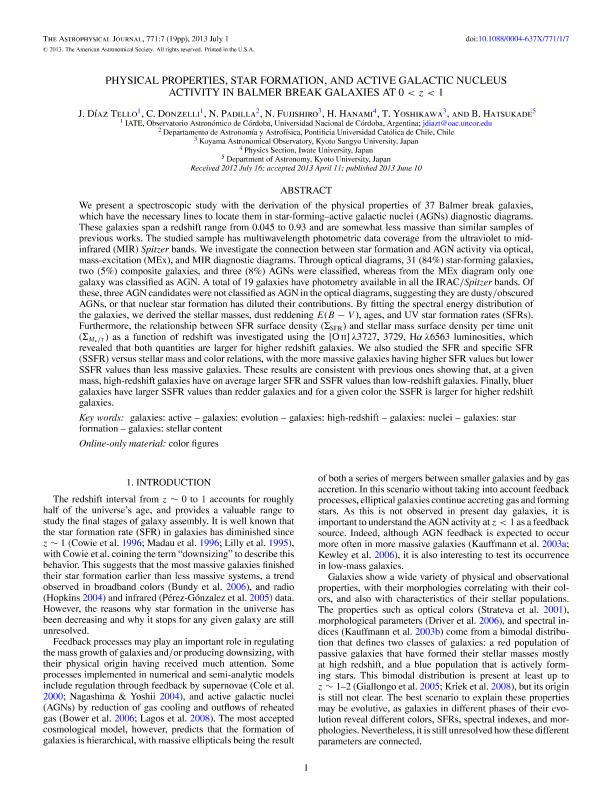Artículo
Physical properties, star formation, and active galactic nucleus activity in Balmer break galaxies at 0 < Z < 1
Diaz Tello, Jorge Andres ; Donzelli, Carlos Jose
; Donzelli, Carlos Jose ; Padilla, Nelson David
; Padilla, Nelson David ; Fujishiro, N.; Hanami, H.; Yoshikawa, T.; Hatsukade, B.
; Fujishiro, N.; Hanami, H.; Yoshikawa, T.; Hatsukade, B.
 ; Donzelli, Carlos Jose
; Donzelli, Carlos Jose ; Padilla, Nelson David
; Padilla, Nelson David ; Fujishiro, N.; Hanami, H.; Yoshikawa, T.; Hatsukade, B.
; Fujishiro, N.; Hanami, H.; Yoshikawa, T.; Hatsukade, B.
Fecha de publicación:
07/2013
Editorial:
IOP Publishing
Revista:
Astrophysical Journal
ISSN:
0004-637X
Idioma:
Inglés
Tipo de recurso:
Artículo publicado
Clasificación temática:
Resumen
We present a spectroscopic study with the derivation of the physical properties of 37 Balmer break galaxies, which have the necessary lines to locate them in star-forming–active galactic nuclei (AGNs) diagnostic diagrams. These galaxies span a redshift range from 0.045 to 0.93 and are somewhat less massive than similar samples of previous works. The studied sample has multiwavelength photometric data coverage from the ultraviolet to midinfrared (MIR) Spitzer bands. We investigate the connection between star formation and AGN activity via optical, mass-excitation (MEx), and MIR diagnostic diagrams. Through optical diagrams, 31 (84%) star-forming galaxies, two (5%) composite galaxies, and three (8%) AGNs were classified, whereas from the MEx diagram only one galaxy was classified as AGN. A total of 19 galaxies have photometry available in all the IRAC/Spitzer bands. Of these, three AGN candidates were not classified as AGN in the optical diagrams, suggesting they are dusty/obscured AGNs, or that nuclear star formation has diluted their contributions. By fitting the spectral energy distribution of the galaxies, we derived the stellar masses, dust reddening E(B − V ), ages, and UV star formation rates (SFRs). Furthermore, the relationship between SFR surface density (ΣSFR) and stellar mass surface density per time unit (ΣM∗/τ ) as a function of redshift was investigated using the [O ii] λ3727, 3729, Hα λ6563 luminosities, which revealed that both quantities are larger for higher redshift galaxies. We also studied the SFR and specific SFR (SSFR) versus stellar mass and color relations, with the more massive galaxies having higher SFR values but lower SSFR values than less massive galaxies. These results are consistent with previous ones showing that, at a given mass, high-redshift galaxies have on average larger SFR and SSFR values than low-redshift galaxies. Finally, bluer galaxies have larger SSFR values than redder galaxies and for a given color the SSFR is larger for higher redshift galaxies.
Palabras clave:
Galaxies
,
Active
,
Evolution
Archivos asociados
Licencia
Identificadores
Colecciones
Articulos(IATE)
Articulos de INST.DE ASTRONOMIA TEORICA Y EXPERIMENTAL
Articulos de INST.DE ASTRONOMIA TEORICA Y EXPERIMENTAL
Citación
Diaz Tello, Jorge Andres; Donzelli, Carlos Jose; Padilla, Nelson David; Fujishiro, N.; Hanami, H.; et al.; Physical properties, star formation, and active galactic nucleus activity in Balmer break galaxies at 0 < Z < 1; IOP Publishing; Astrophysical Journal; 771; 1; 7-2013; 1-19
Compartir
Altmétricas



